The mouse RNase inhibitor market is projected to expand from an estimated USD 193.2 million in 2025 to USD 548.7 million by 2035, reflecting a robust CAGR of 11.0%. This strong growth trajectory reflects increasing demand for RNase inhibitors in molecular biology research, especially in RNA sequencing, gene expression studies, and diagnostics. Rising investments in biotechnology, expanding research applications in genomics, and the growing prevalence of RNA-based therapeutics underpin this growth. Over the forecast period, the market is expected to gain USD 355.5 million in absolute terms, signifying demand and opportunities for innovation across both research and clinical applications.
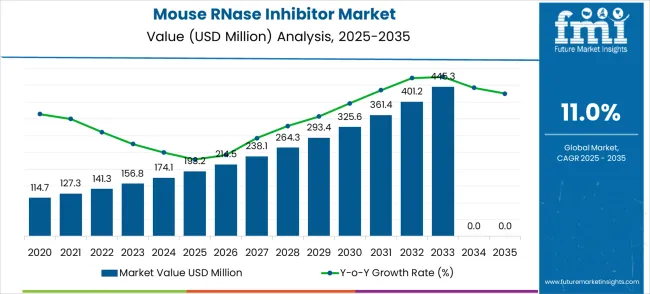
In the short-term forecast (2025–2028), the market shows consistent annual growth ranging from 10% to 11%, with the value increasing from USD 193.2 million in 2025 to USD 264.3 million in 2028. This steady expansion is supported by increased adoption of RNA-based research tools and the integration of mouse RNase inhibitors into advanced laboratory workflows. The first three years of the forecast reflect a growing awareness of RNase contamination risks, especially in precision diagnostics, leading to faster adoption of inhibitor solutions in genomics laboratories worldwide.
| Metric | Value |
|---|---|
| Market Value (2025) | USD 193.2 million |
| Market Forecast Value (2035) | USD 548.7 million |
| Market Forecast CAGR | 11.0% |
Long-term forecasting through 2035, using CAGR and trend analysis, indicates strong growth continuity. From USD 264.3 million in 2028, the market is forecast to rise to USD 548.7 million by 2035, with growth accelerating particularly after 2031. This acceleration is driven by technological advances in RNA preservation, expanding applications in RNA therapeutics, and rising regulatory support for precision molecular testing. By the final forecast year, the market is expected to achieve growth rates above 11%, with heightened adoption in emerging biotechnology hubs across Asia-Pacific and Europe, alongside steady growth in established North American markets.
Scenario analysis suggests variations based on technological adoption rates and funding trends in biotech research. Under an optimistic scenario, driven by faster breakthroughs in RNA therapeutics and expanded research budgets, the market could exceed USD 600 million by 2035. The base scenario aligns with the forecast CAGR of 11.0%, reaching USD 548.7 million. A pessimistic scenario, influenced by slower adoption of advanced inhibitor technology or reduced research funding, could see growth slow to a CAGR closer to 9%, resulting in a market size around USD 490 million by 2035. This range reflects both the strong growth potential and volatility in the market.
Market expansion is being supported by the rapid increase in biotechnology research development worldwide and the corresponding need for high-performance RNA preservation solutions that provide superior RNA stability and research reliability for advanced molecular biology applications. Modern pharmaceutical laboratories and research institutions rely on consistent RNA integrity and experimental reproducibility to ensure optimal research outcomes including drug discovery programs, diagnostic development, and therapeutic research. Even minor RNA degradation can require comprehensive experimental adjustments to maintain optimal research standards and data quality.
The growing complexity of molecular biology requirements and increasing demand for specialized research reagents are driving demand for mouse RNase inhibitors from certified manufacturers with appropriate quality capabilities and technical expertise. Research institutions are increasingly requiring documented performance specifications and purity standards to maintain experimental quality and research reproducibility. Industry specifications and quality standards are establishing standardized research procedures that require specialized mouse RNase inhibitor technologies and trained laboratory personnel.
The rising focus on RNA-based therapeutics and precision medicine research across pharmaceutical and biotechnology sectors is creating substantial market opportunities for mouse RNase inhibitor manufacturers. Advanced molecular biology research incorporating RNA preservation technologies enables superior experimental reliability and data consistency compared to conventional research approaches. Industry trends toward personalized medicine and gene therapy development are further accelerating demand for sophisticated RNA research reagents that require precise mouse RNase inhibitor performance.
The Mouse RNase Inhibitor market is entering a new phase of growth, driven by demand for RNA research advancement, biotechnology expansion, and evolving quality and reproducibility standards. By 2035, these pathways together can unlock USD 120-150 million in incremental revenue opportunities beyond baseline growth.
Pathway A -- Medium-Scale Format Leadership (20KU Products) The 20KU segment already holds the largest share due to its superior versatility and cost-effectiveness. Expanding quality optimization, formulation innovation, and packaging efficiency can consolidate leadership. Opportunity pool: USD 40-50 million.
Pathway B -- Core Research Infrastructure (Biopharmaceutical & Drug Discovery) Biopharmaceutical laboratories account for the largest demand. Growing pharmaceutical research, especially in emerging economies, will drive higher adoption of mouse RNase inhibitors for RNA research management. Opportunity pool: USD 30-38 million.
Pathway C -- Academic Research Expansion (University Laboratories) University laboratories represent significant growth potential with increasing research funding. Research systems optimized for high-quality academic applications can capture substantial growth. Opportunity pool: USD 20-25 million.
Pathway D -- Emerging Market Expansion Asia-Pacific and Latin America present growing demand due to rising biotechnology research. Targeting research institutions and cost-competitive solutions will accelerate adoption. Opportunity pool: USD 15-18 million.
Pathway E -- Gene Therapy & Precision Medicine Integration With increasing personalized medicine research, there is an opportunity to promote inhibitors optimized for advanced therapeutic applications. Opportunity pool: USD 8-10 million.
Pathway F -- Specialized Applications (Diagnostics & Clinical Research) Products optimized for diagnostic development, clinical trials, and specialized research offer premium positioning for high-compliance sectors. Opportunity pool: USD 5-7 million.
Pathway G -- Custom Formulation Services Recurring revenue from custom formulations, bulk supplies, and specialized research support creates long-term revenue streams. Opportunity pool: USD 3-4 million.
Pathway H -- Digital Integration & Quality Tracking Digital quality monitoring, batch tracking, and research optimization can elevate mouse RNase inhibitors into "smart reagent" categories. Opportunity pool: USD 2-3 million.
The market is segmented by product format, application, and region. By product format, the market is divided into 2KU, 10KU, 20KU, 100KU, and others. Based on application, the market is categorized into biopharmaceutical laboratories, university laboratories, and others. Regionally, the market is divided into North America, Europe, East Asia, South Asia & Pacific, Latin America, and Middle East & Africa.
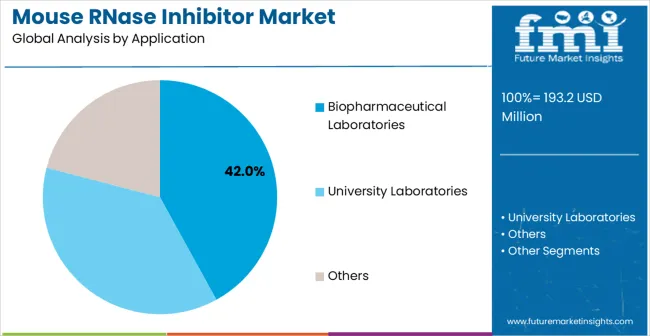
In 2025, the 20KU mouse RNase inhibitor segment is projected to capture around 38% of the total market share, making it the leading product format category. This dominance is largely driven by the widespread adoption of medium-scale research applications that provide optimal balance between reagent economy and experimental flexibility, catering to a wide variety of advanced molecular biology research. 20KU formulations are particularly favored for their ability to deliver superior RNA protection efficiency and cost-effectiveness in both pharmaceutical and academic research installations, ensuring experimental reliability and budget optimization. Pharmaceutical laboratories, biotechnology companies, diagnostic developers, and research institutions increasingly prefer this configuration, as it meets demanding RNA preservation requirements without imposing excessive cost constraints or storage complexity.
The availability of well-established manufacturing processes, along with comprehensive technical support options and standardized packaging formats from leading suppliers, further reinforces the segment's market position.

The biopharmaceutical laboratories segment is expected to represent 42% of mouse RNase inhibitor demand in 2025, highlighting its position as the most significant application sector. This dominance stems from the critical RNA research requirements of modern pharmaceutical environments, where RNA stability and experimental reproducibility are essential to drug discovery performance and therapeutic development. Biopharmaceutical laboratories often feature extensive molecular biology workflows that demand specialized mouse RNase inhibitors throughout complex research protocols, requiring reliable and high-performance RNA preservation solutions. Mouse RNase inhibitors are particularly well-suited to these environments due to their ability to provide consistent RNA protection and experimental reliability, even during intensive research operations and varying experimental conditions. As pharmaceutical research expands globally and emphasizes improved quality standards, the demand for mouse RNase inhibitors continues to rise.
The segment also benefits from heightened drug development requirements within the pharmaceutical industry, where researchers are increasingly prioritizing experimental reliability and data consistency as essential research measures.
The market is advancing rapidly due to increasing biotechnology research development and growing recognition of RNA preservation advantages over traditional research approaches in high-sensitivity applications. The market faces challenges including higher costs compared to basic research reagents, need for specialized storage and handling expertise, and complex compatibility requirements with existing laboratory protocols across different research environments. Quality optimization efforts and advanced preservation technology programs continue to influence reagent development and market adoption patterns.
The growing development of advanced RNA analysis techniques and enhanced preservation methods is enabling superior research outcomes with improved data reliability and reduced experimental variability. Advanced RNA technologies and optimized preservation protocols provide superior research performance while maintaining experimental flexibility requirements. These technologies are particularly valuable for pharmaceutical researchers who require reliable RNA preservation that can support extensive research operations with consistent high-quality results.
Modern mouse RNase inhibitor manufacturers are incorporating advanced quality control capabilities and specialized formulations that enhance research performance and experimental effectiveness. Integration of optimized preservation technologies and enhanced stability systems enables superior research optimization and comprehensive quality management capabilities. Advanced preservation features support operation in diverse research environments while meeting various performance requirements and quality specifications.
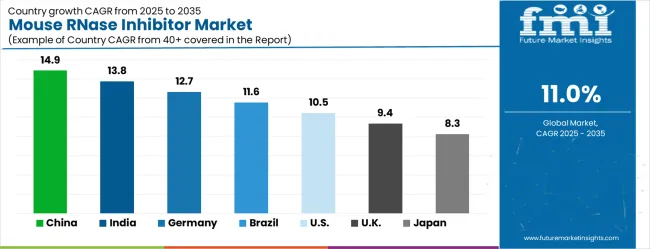
| Country | CAGR (2025-2035) |
|---|---|
| China | 14.9% |
| India | 13.8% |
| Germany | 12.7% |
| Brazil | 11.6% |
| United States | 10.5% |
| United Kingdom | 9.4% |
| Japan | 8.3% |
The market is growing rapidly, with China leading at a 14.9% CAGR through 2035, driven by massive biotechnology research expansion and increasing adoption of advanced molecular biology solutions. India follows at 13.8%, supported by rising pharmaceutical research development and growing awareness of RNA preservation benefits. Germany grows strongly at 12.7%, integrating advanced research technology into its established biotechnology infrastructure. Brazil records 11.6%, focusing research sector modernization and laboratory upgrade initiatives. The United States shows solid growth at 10.5%, focusing on pharmaceutical research expansion and quality optimization. The United Kingdom demonstrates steady progress at 9.4%, maintaining established research applications. Japan records 8.3% growth, concentrating on technology advancement and research efficiency optimization.
The report covers an in-depth analysis of 40+ countries; top-performing countries are highlighted below.
China is expected to achieve a CAGR of 14.9% from 2025 to 2035, driven by strong growth in molecular biology research, pharmaceutical development, and biotechnology. Mouse RNase inhibitors are essential in protecting RNA integrity during experiments, particularly in genomics, transcriptomics, and diagnostics. Chinese manufacturers are investing heavily in advanced biotechnology facilities and high-quality reagent production to meet growing demand. Rising government funding for life sciences research, increasing biotech startups, and expanding pharmaceutical R&D contribute significantly to market expansion. Collaborations between universities and biotech companies are fostering innovation in reagent design. Growing adoption of next-generation sequencing and RNA-based research fuels demand for high-performance inhibitors in China.
India is projected to grow at a CAGR of 13.8% from 2025 to 2035, driven by expansion in biotechnology research, molecular diagnostics, and pharmaceutical innovation. Mouse RNase inhibitors are essential tools for RNA preservation in laboratory workflows. Indian manufacturers are investing in cost-efficient production and development of high-quality reagents to cater to research institutions and diagnostic centers. Growth is supported by expanding genomics and molecular biology research, increased collaborations between academic institutions and biotech firms, and government initiatives promoting life sciences. Rising pharmaceutical R&D and demand for RNA-based diagnostics further propel market growth. Increasing awareness of RNA research benefits strengthens adoption.
Germany is expected to grow at a CAGR of 12.7% from 2025 to 2035, supported by strong biotechnology infrastructure, advanced research capabilities, and regulatory frameworks. Mouse RNase inhibitors are widely used in RNA-focused research, diagnostics, and drug development. German manufacturers emphasize high purity, stringent quality control, and advanced reagent technologies. Demand is driven by growing genomics research, expansion of diagnostic laboratories, and pharmaceutical innovation. Collaborations between biotech firms and academic institutions are enhancing product development. Adoption is particularly strong in RNA sequencing, transcriptomics, and clinical diagnostics. Germany’s leadership in life sciences research maintain steady demand for advanced mouse RNase inhibitors.
Brazil is expected to grow at a CAGR of 11.6% during 2025–2035, driven by growth in life sciences research, diagnostics, and academic applications. Mouse RNase inhibitors are essential for RNA preservation in molecular biology workflows and diagnostics. Local manufacturers focus on cost-effective production while importing high-performance reagents for advanced research. Growth is fueled by increased investment in biotechnology research centers, expanding diagnostic services, and government initiatives promoting scientific innovation. Adoption is growing in universities, research laboratories, and pharmaceutical R&D centers. Strategic collaborations with global reagent suppliers enhance access to high-quality products and technology transfer.
The United States is forecasted to grow at a CAGR of 10.5% between 2025 and 2035, driven by strong demand in pharmaceutical R&D, academic research, and diagnostics. Mouse RNase inhibitors are essential for high-fidelity RNA analysis in genomics, transcriptomics, and clinical diagnostics. Manufacturers are investing in high-quality reagent design, automation in production, and regulatory compliance. Growth is supported by expansion in RNA-based therapeutic research, genome sequencing, and molecular diagnostics. Adoption is particularly strong in biotech research facilities and pharmaceutical quality control labs. Collaborations with academic institutions and reagent suppliers enhance innovation. Increasing investments in life sciences and biomedical research sustain market expansion in the USA
The United Kingdom is projected to grow at a CAGR of 9.4% during 2025–2035, driven by expansion in biotechnology, diagnostics, and molecular biology research. Mouse RNase inhibitors are integral to RNA analysis, ensuring stability and integrity in diagnostic and research workflows. UK manufacturers focus on innovation, high-purity reagents, and adherence to stringent quality standards. Growth is supported by rising genomics research, expansion of clinical diagnostics, and pharmaceutical R&D. Collaborations between universities and biotech firms foster product advancement. Increased government funding for life sciences projects further drives adoption. Demand is growing in both academic and commercial research sectors.
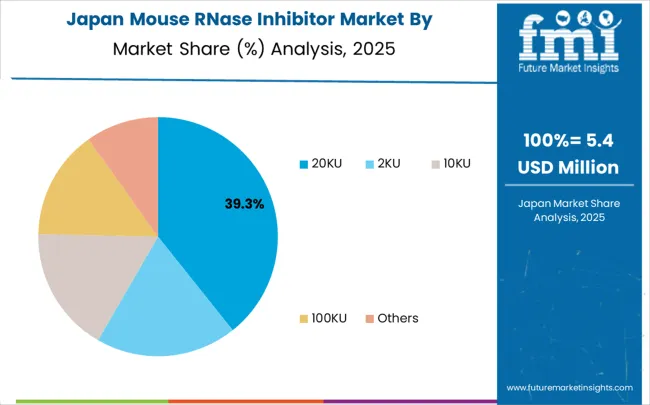
Japan is forecasted to grow at a CAGR of 8.3% between 2025 and 2035, supported by advanced biotechnology infrastructure, strong R&D investment, and high regulatory standards. Mouse RNase inhibitors are critical for RNA integrity in research, diagnostics, and pharmaceutical applications. Japanese manufacturers focus on high-precision reagent production, quality assurance, and innovation. Growth is driven by expanding genomics research, increasing RNA-based diagnostic development, and pharmaceutical R&D. Adoption is also growing in academic institutions and clinical laboratories. Collaborations with global biotech firms ensure technology transfer and product quality improvement. Japan’s focus on high-quality life sciences research maintain steady inhibitor market growth.
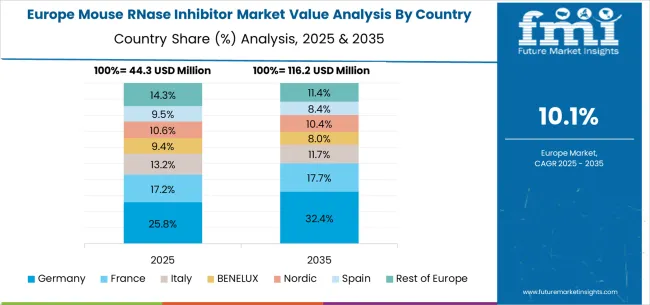
The mouse RNase inhibitor market in Europe is forecast to expand from USD 50.4 million in 2025 to USD 143.2 million by 2035, registering a CAGR of 11.0%. Germany will remain the largest market, holding 34.7% share in 2025, easing to 34.3% by 2035, supported by strong biotechnology infrastructure and advanced research standards. The United Kingdom follows, rising from 25.6% in 2025 to 26.0% by 2035, driven by research facility modernization and molecular biology enhancement initiatives. France is expected to maintain stability from 18.9% to 18.6%, reflecting consistent biotechnology investments and research requirements. Italy holds around 12.2% throughout the forecast period, supported by research facility upgrades and biotechnology infrastructure modernization programs. Spain grows from 5.8% to 6.2% with expanding biotechnology infrastructure and increased focus on advanced research solutions. BENELUX markets maintain 2.3% to 2.2%, while the remainder of Europe hovers near 0.5%--0.7%, balancing emerging Eastern European research development against mature Nordic markets with established molecular biology technology adoption patterns.
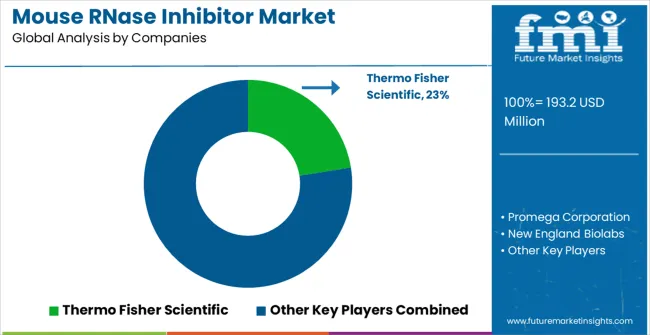
The market is defined by competition among specialized molecular biology manufacturers, biotechnology reagent companies, and research solution providers. Companies are investing in advanced preservation technology development, formulation innovation, quality optimization, and comprehensive technical service capabilities to deliver reliable, high-performance, and cost-effective molecular biology solutions. Strategic partnerships, technological innovation, and market expansion are central to strengthening product portfolios and market presence.
Thermo Fisher Scientific offers comprehensive molecular biology solutions with established manufacturing expertise and professional-grade research capabilities. Promega Corporation provides specialized biotechnology reagents with focus on quality reliability and research performance. New England Biolabs delivers advanced molecular biology solutions with focus on preservation efficiency and laboratory-friendly operation. Roche specializes in biotechnology products with advanced manufacturing integration.
QIAGEN GmbH offers professional-grade research equipment with comprehensive technical support capabilities. Merck delivers established biotechnology solutions with advanced preservation technologies. Bio-Rad Laboratories provides specialized molecular biology equipment with focus on quality optimization. Aladdin, TIANGEN Biotech, Amyjet Scientific, Vazyme Biotech, Bioer Technology, and Yeasen offer specialized manufacturing expertise, product reliability, and comprehensive development across global and regional biotechnology market segments.
| Item | Value |
|---|---|
| Quantitative Units | USD 193.2 million |
| Product Format | 2KU, 10KU, 20KU, 100KU, Others |
| Application | Biopharmaceutical Laboratories, University Laboratories, Others |
| Regions Covered | North America, Europe, East Asia, South Asia & Pacific, Latin America, Middle East & Africa |
| Country Covered | China, India, Germany, Brazil, United States, United Kingdom, Japan, and 40+ countries |
| Key Companies Profiled | Thermo Fisher Scientific, Promega Corporation, New England Biolabs, Roche, QIAGEN GmbH, Merck, Bio-Rad Laboratories, Aladdin, TIANGEN Biotech, Amyjet Scientific, Vazyme Biotech, Bioer Technology, Yeasen |
| Additional Attributes | Dollar sales by product format and application segment, regional demand trends across major markets, competitive landscape with established molecular biology manufacturers and emerging biotechnology providers, customer preferences for different formulation configurations and quality options, integration with research protocols and laboratory workflows, innovations in RNA preservation technology and inhibitor efficiency, and adoption of advanced formulation features with enhanced stability capabilities for improved research outcomes. |
The global mouse RNase inhibitor market is estimated to be valued at USD 193.2 million in 2025.
The market size for the mouse RNase inhibitor market is projected to reach USD 548.7 million by 2035.
The mouse RNase inhibitor market is expected to grow at a 11.0% CAGR between 2025 and 2035.
The key product types in mouse RNase inhibitor market are 20ku, 2ku, 10ku, 100ku and others.
In terms of application, biopharmaceutical laboratories segment to command 42.0% share in the mouse RNase inhibitor market in 2025.






Our Research Products

The "Full Research Suite" delivers actionable market intel, deep dives on markets or technologies, so clients act faster, cut risk, and unlock growth.

The Leaderboard benchmarks and ranks top vendors, classifying them as Established Leaders, Leading Challengers, or Disruptors & Challengers.

Locates where complements amplify value and substitutes erode it, forecasting net impact by horizon

We deliver granular, decision-grade intel: market sizing, 5-year forecasts, pricing, adoption, usage, revenue, and operational KPIs—plus competitor tracking, regulation, and value chains—across 60 countries broadly.

Spot the shifts before they hit your P&L. We track inflection points, adoption curves, pricing moves, and ecosystem plays to show where demand is heading, why it is changing, and what to do next across high-growth markets and disruptive tech

Real-time reads of user behavior. We track shifting priorities, perceptions of today’s and next-gen services, and provider experience, then pace how fast tech moves from trial to adoption, blending buyer, consumer, and channel inputs with social signals (#WhySwitch, #UX).

Partner with our analyst team to build a custom report designed around your business priorities. From analysing market trends to assessing competitors or crafting bespoke datasets, we tailor insights to your needs.
Supplier Intelligence
Discovery & Profiling
Capacity & Footprint
Performance & Risk
Compliance & Governance
Commercial Readiness
Who Supplies Whom
Scorecards & Shortlists
Playbooks & Docs
Category Intelligence
Definition & Scope
Demand & Use Cases
Cost Drivers
Market Structure
Supply Chain Map
Trade & Policy
Operating Norms
Deliverables
Buyer Intelligence
Account Basics
Spend & Scope
Procurement Model
Vendor Requirements
Terms & Policies
Entry Strategy
Pain Points & Triggers
Outputs
Pricing Analysis
Benchmarks
Trends
Should-Cost
Indexation
Landed Cost
Commercial Terms
Deliverables
Brand Analysis
Positioning & Value Prop
Share & Presence
Customer Evidence
Go-to-Market
Digital & Reputation
Compliance & Trust
KPIs & Gaps
Outputs
Full Research Suite comprises of:
Market outlook & trends analysis
Interviews & case studies
Strategic recommendations
Vendor profiles & capabilities analysis
5-year forecasts
8 regions and 60+ country-level data splits
Market segment data splits
12 months of continuous data updates
DELIVERED AS:
PDF EXCEL ONLINE
Mouse TNF-α Kit Market Size and Share Forecast Outlook 2025 to 2035
Mouse T Cell Isolation Kit Market Size and Share Forecast Outlook 2025 to 2035
Mouse Elevated Cross Maze Market Size and Share Forecast Outlook 2025 to 2035
Rat and Mouse Forced Swimming Test System Market Size and Share Forecast Outlook 2025 to 2035
Wireless Mouse Market
Humanized Mouse Model Market Size and Share Forecast Outlook 2025 to 2035
FcRn Inhibitors Market Size and Share Forecast Outlook 2025 to 2035
PARP Inhibitor Market Analysis – Size, Share, and Forecast Outlook 2025 to 2035
CGRP Inhibitors Market Trends - Growth, Demand & Forecast 2025 to 2035
Global KRAS Inhibitor Market Analysis – Size, Share & Forecast 2024-2034
PCSK9 Inhibitor Market Forecast Outlook 2025 to 2035
SGLT2 Inhibitors Market Size and Share Forecast Outlook 2025 to 2035
SGLT2 Inhibitors Treatment Market Overview – Trends & Growth 2024-2034
NF-KB Inhibitors Market
Mould Inhibitors Market
Kinase Inhibitors For Cancer Treatment Market Size and Share Forecast Outlook 2025 to 2035
Kinase Inhibitor in Autoimmune Diseases Market Size and Share Forecast Outlook 2025 to 2035
Enzyme Inhibitors Market
Galectin Inhibitor Therapeutics Market
Paraffin Inhibitors Market

Thank you!
You will receive an email from our Business Development Manager. Please be sure to check your SPAM/JUNK folder too.
Chat With
MaRIA